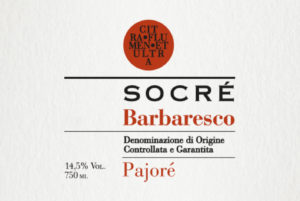
The Estate
For a long time, Socré exclusively sold their grapes to local farmers who made wine for their own enjoyment, as well as to neighboring wineries. Since 1999, they have ramped up their wine production exponentially and brought the winery into the 21st century.
This small estate owns vineyards in Roncaglie, one of the Grand Crus of Barbaresco D.O.C.G. area. The vines (with ages ranging from 10 to 50 years) are planted with a density ranging from 4,500 vines per ha up to 6,000 vines per ha.
Owners: Marco, Giulio, and Lorenzo Piacentino
Winemaker: Fabrizio Torchio
Production Area: 7.5 hectares of vineyards in Barbaresco, Piedmont – Roncaglie

Barbaresco
Overview: Socré’s flagship wine
Grape Varietals: 100% Nebbiolo
Exposition: South, Southwest
Altitude: 240-280m a.s.l.
Soil: Clayey with limestone
Training System: Guyot – 5000 vines/ha
Plantation Year: 1966, 2000
Yield: 1.4 kg/vine; 50 hl/ha
Harvest: October
Fermentation: Done in 25 hl vats of French oak and 30 hl stainless steel vats at a controlled temperature of 29°C
Maceration: Lasts 14 days with pumping over and pigeages
Aging: 18 months in French oak used barriques (2nd and 3rd passage) + 6 months in concrete vats
Bottle Aging: At least 6 months
Alcohol: 14%
Annual Production: 35,000 bottles

Barbaresco Roncaglie
Grape Variety: 100% Nebbiolo
Aging: 12-15 months in French oak barrels (225 liters) of which one-third is new, and 12 months in large oak casks (20 hl). Refinement continues in the bottle for at least other 12 months before sale.
Tasting Notes: The color is a deep, garnet red. Elegant bouquet of violets with accompanying balsamic, mint, and cherry jam notes. The palate is soft and smooth with dense and silky tannins. This is the perfect wine for special occasions.
Alcohol: Between 14.0 and 14.5% vol.
Dry Extract: Higher than 30 g/liter
Cellaring: Great potential for aging (at least 20 years)
Serving Suggestion: Best consumed at 18-19°C in large crystal glasses. Recommended pairings are roast red meat and wild game.

Barbaresco Pajoré
Vineyard Site: The Pajoré cru is bordered by Roncaglie and Montaribaldi, in the municipality of Barbaresco, and is one of most famous vineyards in Langhe.
Grape Variety: Nebbiolo
Alcohol: 14.5%

Cisterna d'Asti De Scapin
Overview: Croatina, widespread in the relatively far region of Oltrepò Pavese, is a grape variety that is little cultivated in Piedmont; its presence is largely restricted to Tortona, High Piedmont, and in the district of Cisterna d’Asti (between Monferrato and Roero, and on the border of the province of Asti and Cuneo). Traditional wine of Cisterna d’Asti has an intense purplish red color, and has a characteristic astringent aftertaste. De Scapin is produced as a still wine, although the specification allows for the possibility of a lively sparkling version, with 100% of the Croatina grapes coming from the municipality of Cisterna d’Asti, in Varija Bellegardo.
Name: “De Scapin” references the surname of the owners’ mother, Rosella. She was born in Cisterna d’Asti and contributed greatly in the creation of the DOC specification of the wine. Her surname is actually Scapino, but in the day-to-day use in Cisterna, where Piemontese dialect is often used, her surname becomes De Scapin (meaning “of the Scapino family”).
Production Area: Cisterna d’Asti – Monferrato – Piemonte
Grape Variety: 100% Croatina
Exposition: South, southeast
Altitude: 250-270 meters above sea level
Soil: Sandy clay with limestone
Training System: Guyot
Plant Density: 5,000 vines/ha
First Planting: 2001
Average Yield: 1.2 kg/vine; 42 hl/ha
Fermentation: In 30 hl stainless steel vats at a controlled temperature (within 30 degrees). Maceration lasts 15 days with pumping over and pigeages.
Aging: 18 months in used French oak barriques (2nd passage + more) plus 12 months in stainless steel vats. Bottle aged for 12 months at least.
Tasting Notes: Purplish red in color, almost impenetrable. Fruity with vegetable notes. Soft texture and deep, sustained body with evident tannins. This is a wine of great class and immediate pleasure.
Food Pairings: Pairs well with rich dishes (cheeses, meats) that are enhanced by the tannins of the wine.
Alcohol: 14.5%

Langhe Freisa
Production Area: Langhe
Grape Varieties: 100% Freisa. Freisa is a red grape variety grown in mainly in the Piedmont region of Italy, and is a genetic parent grape to the Nebbiolo variety.
Exposition: East
Altitude: 240 m a.s.l.
Soil: Clay with limestone
Training System: Guyot – 5,000 vines/ha
First Planting: 1990
Yield: 1,4 kg/vine; 49 Hl/ha
Harvest: Last week of September
Fermentation: Done in 30 hl stainless steel vats at an uncontrolled temperature (within 30°C). Maceration lasts 15 days with pumping over and pigeages.
Aging: 12 months in only used barriques and 6 months in stainless steel vats. Bottle aging for at least 6 months.
Alcohol: 14%


